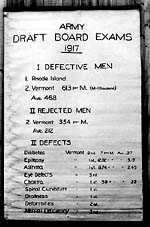

 Professor Henry F. Perkins began teaching eugenics in his new Heredity
course in 1921. College biology texts of the 1920s integrated concepts of
human heredity with discussions of eugenics and attributed the complex
social problems of crime, dependency, and immorality to specific genes for
feeblemindedness, mental illness, or personality disorders. Studies of
identical twins, construction of family pedigrees, and field trips to
state institutions reinforced hereditary explanations for human nature.
Motivated students continued their study of human heredity in a semester
of independent research on a topic of their choice.
Professor Henry F. Perkins began teaching eugenics in his new Heredity
course in 1921. College biology texts of the 1920s integrated concepts of
human heredity with discussions of eugenics and attributed the complex
social problems of crime, dependency, and immorality to specific genes for
feeblemindedness, mental illness, or personality disorders. Studies of
identical twins, construction of family pedigrees, and field trips to
state institutions reinforced hereditary explanations for human nature.
Motivated students continued their study of human heredity in a semester
of independent research on a topic of their choice.
 Always
in search of independent projects that would engage student interest
in real world problems, Dr. Perkins wrote to Charles B. Davenport at Cold
Spring Harbor for suggestions. At Davenport's urging, he turned Vermont's
rate of draft rejects into a class project in 1924 and sent his first student
to the summer program at the Eugenics Records Office at Cold Spring Harbor
to study the draft board results.
Always
in search of independent projects that would engage student interest
in real world problems, Dr. Perkins wrote to Charles B. Davenport at Cold
Spring Harbor for suggestions. At Davenport's urging, he turned Vermont's
rate of draft rejects into a class project in 1924 and sent his first student
to the summer program at the Eugenics Records Office at Cold Spring Harbor
to study the draft board results.
I had for some years prior to 1925 conducted at the University of Vermont a course on Heredity. Lacking definite information about Vermont families, it was impossible to answer many of the questions propounded by students and people in audiences whom I was asked to address on the subject.... It was all very well to bring forth the results of studies on the Jukes, the Kallikaks, Nams, and other graphic examples of degeneracy, and by contrast the successive generation of notables among the Jonathan Edwards or Hirschoff families, but Vermont Students wanted Vermont facts." |
Henry F. Perkins, |
 Perkins'
search for Vermont facts brought him into contact with the leaders of the
social reform coalition. In 1925 he obtained $2500 from Mrs. Emily Proctor
Eggleston, an incorporator and benefactor of the Vermont Children's Aid
Society (VCAS), to conduct a survey of the families who had occupied the
attention of social workers for the previous decade. The Vermont Children's
Aid Society donated the services of Harriett Abbott, district agent in
Bellows Falls, to serve as field investigator:
Perkins'
search for Vermont facts brought him into contact with the leaders of the
social reform coalition. In 1925 he obtained $2500 from Mrs. Emily Proctor
Eggleston, an incorporator and benefactor of the Vermont Children's Aid
Society (VCAS), to conduct a survey of the families who had occupied the
attention of social workers for the previous decade. The Vermont Children's
Aid Society donated the services of Harriett Abbott, district agent in
Bellows Falls, to serve as field investigator:
We were glad to release a valued member of our staff, Miss Harriett Abbott, to work under the direction of the State University in making a eugenical study of Vermont. No longer are child-caring agencies content to patch up broken little lives. Work of prevention is now recognized as more important. Societies which have intimate contact with children who are homeless, destitute, and neglected have laid upon them an obligation to bring to the general public not only the extent of this suffering, but the underlying conditions which beget it." |
L. Josephine Webster, |
The idea of a Eugenics Survey attracted Vermont's leaders in social reform, as they had urged the state for years to develop comprehensive, integrated state programs in child welfare, mental health, and charity and corrections. Recognizing their authority, Perkins incorporated all the long-sought social reforms into his 1925 plan for "A Good Eugenics Program for Vermont." Over the next decade, the Survey would assume a more important role in zoology education at UVM.